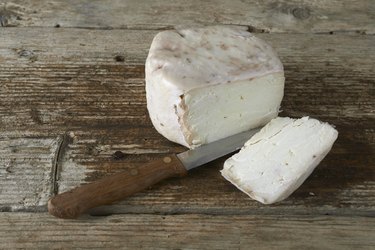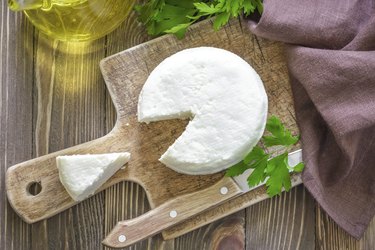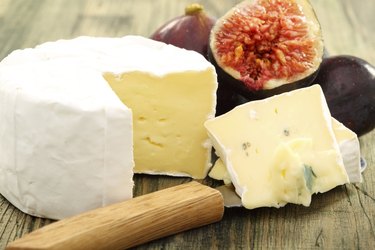
Chevre means goat in French, but it has also come to mean almost any cheese made from goat's milk. Goat's milk cheeses may be soft, semi-soft or firm, ripened or unripened. Most goat cheese found in stores in the United States came from France, but more and more domestic goat dairies are producing cheeses, and you may find goat cheese sold at local farmers' markets.
Soft, Unripened Cheese
Video of the Day

Most cheeses start as curds. Curds that are drained and seasoned become cottage cheese. If the curds are drained and then pressed together, the result is a semi-soft cheese, sometimes flavored with herbs or stored in oil. This cheese is often sold in logs and is what most people think of when they think of chevre, or goat cheese. It requires no ripening and can be eaten as soon as its made, spread on crackers or mixed into dips. Another variety of unripened cheese made with goat's milk is crottin. This tangy cheese can be served soft, but the curds are often allowed to dry and crumble, similar to a feta cheese.
Video of the Day
Hard, Unripened Cheese

Gjetost is a firm, caramel-colored cheese with a sweet, buttery flavor, imported from Norway. To make this cheese, a mixture of goat's milk, cream and whey is cooked down to a caramel consistency. Gjetost is usually sold in small cubes. Chevre sec is an unripened, dry cheese similar to Romano. It can be grated for use in recipes or on salads.
Ripened Cheeses

Chevrefeuille and chevrita are two soft, ripened cheeses similar to brie or Camembert. The little wheels of cheese are covered with a white mold and allowed to age for several weeks or months. Like brie, chevregeuille and chevrita can be eaten raw or baked. Some cheese makers make hard cheeses similar to Swiss, jack and cheddar, using goat's milk instead of cow's milk. These cheeses are aged for several months before eating, and the goat versions taste very similar to varieties made with cow's milk.